The AMD Radeon R9 380X Review, Feat. ASUS STRIX
by Ryan Smith on November 23, 2015 8:30 AM EST- Posted in
- GPUs
- AMD
- Radeon
- Asus
- Radeon 300
Power, Temperature, & Noise
As always, last but not least is our look at power, temperature, and noise. Next to price and performance of course, these are some of the most important aspects of a GPU, due in large part to the impact of noise. All things considered, a loud card is undesirable unless there’s a sufficiently good reason – or sufficiently good performance – to ignore the noise.
Unfortunately we don’t have any tools that can read the GPU voltage on the ASUS card, so we’ll jump right into average clockspeeds.
| Radeon R9 380X Average Clockspees | |||
| Game | ASUS R9 380X (OC) | ASUS R9 380X (Ref) | |
| Max Boost Clock | 1030MHz | 970MHz | |
| Battlefield 4 |
1030MHz
|
970MHz
|
|
| Crysis 3 |
1030MHz
|
970MHz
|
|
| Mordor |
1030MHz
|
970MHz
|
|
| Dragon Age |
1030MHz
|
970MHz
|
|
| Talos Principle |
1030MHz
|
970MHz
|
|
| Total War: Attila |
1030MHz
|
970MHz
|
|
| GRID Autosport |
1030MHz
|
970MHz
|
|
| Grand Theft Auto V |
1030MHz
|
970MHz
|
|
The ASUS R9 380X has no problem holding its full boost clockspeed in games, both at its stock speed of 1030MHz and when downclocked to 970MHz.
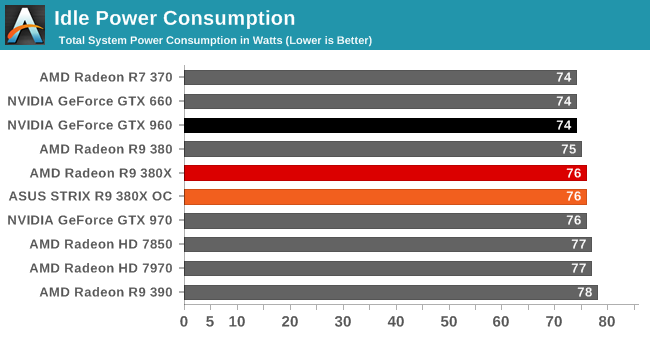
Starting with idle power consumption, the ASUS card comes in right where we’d expect it. 75-76W is typical for a Tonga card on our GPU testbed.

Moving on to power consumption under Crysis 3, like so many other aspects of R9 380X, its performance here is very close to the original R9 380. Power consumption is up slightly thanks to the additional CUs and the additional CPU load from the higher framerate, with the reference clocked R9 380X coming in at 299W, while ASUS’s factory overclock pushes that to 304W.
The problem for AMD is that this is smack-dab in GTX 970 territory. Meanwhile the GTX 960, though slightly slower, is drawing 74W less at the wall. R9 380 just wasn’t very competitive on power consumption compared to Maxwell, and R9 380X doesn’t do anything to change this. AMD’s power draw under games is essentially one class worse than NVIDIA’s – the R9 380X draws power like a GTX 970, but delivers performance only slightly ahead of a GTX 960.
The one bit of good news here for AMD is that while the power consumption of the R9 380X isn’t great, it’s still better balanced than the R9 390. With AMD opting to push the envelope there to maintain price/performance parity with the GTX 970, while the R9 380X is a fair bit slower than the R9 390, it saves a lot of power in the process. And for that matter the R9 380X shows a slight edge over the 7970, delivering similar gaming performance for around 16W less at the wall.
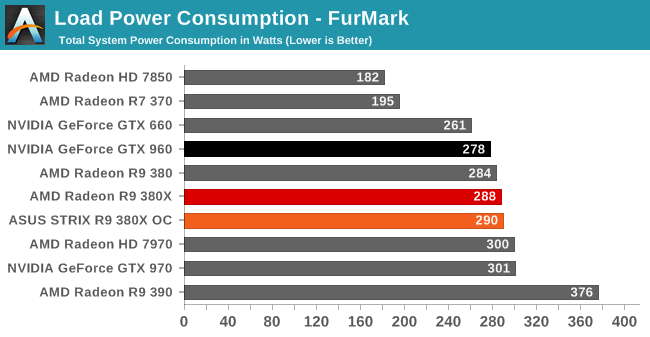
Moving over to FurMark our results get compressed by quite a bit (we’re using a GTX 960 with a fairly high power limit), but even then the R9 380X’s power consumption isn’t in AMD’s favor. At best we can say it’s between the GTX 960 and GTX 970, with the former offering performance not too far off for less power.
Otherwise as was the case with Crysis 3, the R9 380X holds a slight edge over the 7970 on power consumption. This despite the fact that the R9 380X uses AMD’s newer throttling technology, and consequently it gets closer to its true board limit than the 7970 ever did.
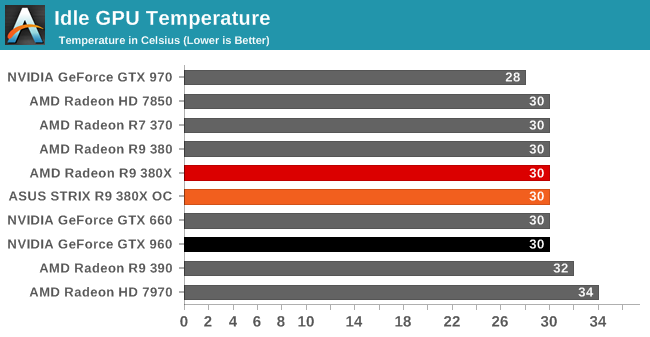
With idle temperatures ASUS’s 0db Fan technology doesn’t hamper the R9 380X at all. Even without any direct fan airflow the STRIX R9 380X holds at 30C.
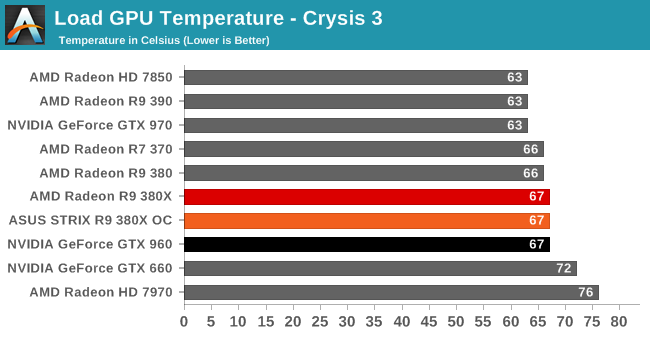
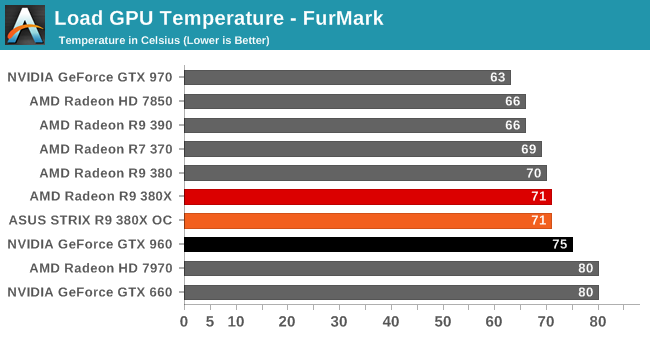
Load temperatures also look good. ASUS’s sweet spot seems to be around 70C – right where we like to see it for an open air cooled card – with the R9 380X reaching equilibrium at 67C for Crysis 3 and 71C for FurMark.
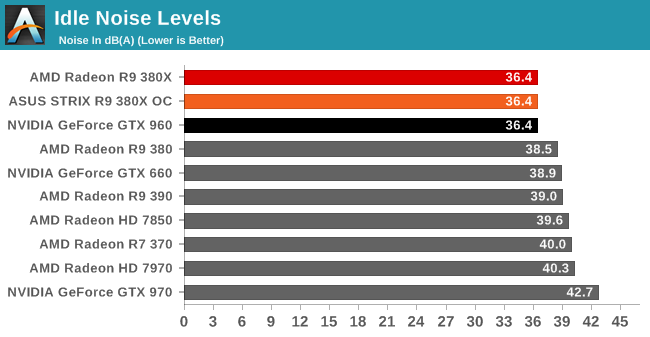
Finally with idle noise, the zero fan speed idle technology on the STRIX lineup means that the STRIX R9 380X gets top marks here. At 36.4dB the only noise coming from our system is closed loop liquid cooler for the CPU. The video card is completely silent.
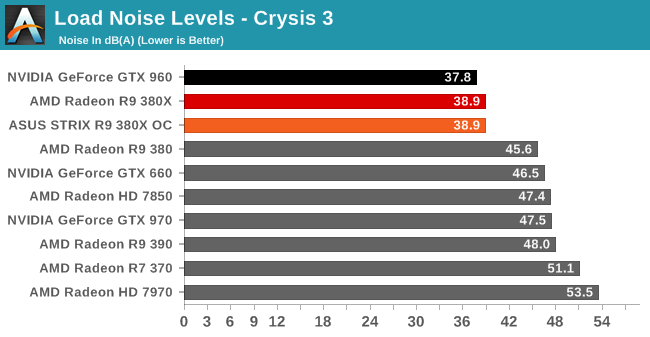
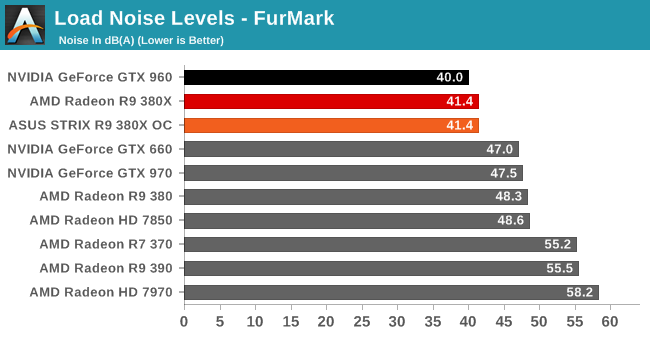
Shifting over to load noise levels then, the STRIX R9 380X continues to impress. With Crysis 3 the card tops out at 38.9dB – less then 3dB off of our noise floor – and that goes for both when the card is operating at AMD’s reference clocks and ASUS’s factory overclock. At this point the STRIX R9 380X is next-to-silent; it would be hard to do too much better without using an entirely passive cooling setup. So for ASUS to dissipate what we estimate to be 175W or so of heat while making this little noise is nothing short of impressive.
Meanwhile with FurMark the ASUS card needs to work a bit harder, but it still offers very good results. Even with the card maxed out we’re looking at just 41.4dB. The STRIX R9 380X isn’t silent, but it gets surprisingly close for such a powerful card.










101 Comments
View All Comments
funkforce - Monday, November 23, 2015 - link
Haha, funny you should ask that...Check the comments...
January 2015
http://www.anandtech.com/show/8923/nvidia-launches...
http://www.anandtech.com/show/9547/nvidia-launches...
http://www.anandtech.com/comments/9390/the-amd-rad...
"jeffrey - Thursday, July 02, 2015 - link
Ryan Smith, any update on GTX 960
REPLY
Ryan Smith - Thursday, July 02, 2015 - link
As soon as Fury is out of the way. "
http://www.anandtech.com/comments/9621/the-amd-rad...
extide - Monday, November 23, 2015 - link
Looks like you missed a comment, because there was one at one point that said that there will not be a 960 review. I don't have a direct link to it because I'm not obsessed with the topic, but yeah, it was said.funkforce - Monday, November 23, 2015 - link
You're right, I don't know when that was said. I waited months for that review, because I trust the unbiased reviews here and wanted to buy a new graphics card based on info I could count on.And I just really don't like when you keep promising things, stringing your readers on, and then never delivering. I don't care if the review gets posted, it's just how it was handled. I've been raised that a person's word means something (he told me personally on twitter that he would do it). And I'm sure you could go on that this is the internet etc. but when you've been reading a site since it's start, it's content means something, at least to me. I guess it's why we're all here to some extent. If you go back on your word, then you should at least let ppl. know, a bit more officially, than in a comment section of, I would assume, another article.
Samus - Monday, November 23, 2015 - link
The problem with reviewing the GTX960 is the drivers have been optimizing around improving its performance all year, and every single card performs so different. The GTX960 overclocks incredibly well, some people hit 1400MHz is the board has the right power configuration. This is why you hear people talk about the GTX960 completely trumping the R9 28x/38x's when in reality, both GPU's give and take blows in various games at stock.But when overclocked, the GTX960 is a bit faster than an overclocked R9 28x/38x. I think this causes a lot of reviewers to tip-toe around these cards. And when you consider a GTX960 with 4GB is over $200 and a GTX970 with 4GB (er technically 3.5GB) is $260-$280 after rebate, it becomes muddled.
OrphanageExplosion - Tuesday, November 24, 2015 - link
I own the GTX 960. Mine hits 1450MHz easily. I think they all do because temps and power consumption barely budge. I also own the R9 380 in 4GB configuration.Drivers have barely improved the 960 performance and the 380 is faster in almost every game I own. Overclocking gets the 960 to parity, or slightly better to a small extent where you can't really tell the difference.
Of the two I'd take the 960 simply due to the efficiency, but driver updates have really made no difference to anything other than the games they were optimised for. Library titles have seen no improvement.
dananski - Monday, November 23, 2015 - link
I also waited a while, checking the site often. I think I spotted some 960 benchmarks slipped into some analysis article on here many months later, but no post to say they'd been done, let alone a full review.It's not just the graphics section either. I really don't get why there are so many announcements and so few reviews on here these days. It's a shame because reviews like this one here are the reason I like AnandTech so much.
olivaw - Monday, November 23, 2015 - link
I wanted the GTX 960 reviewed because it seems to be pretty good for an HTPC, since the power consumption is lower than most chips. I know the card is good, but I wanted an AnandTech review :)drwhoglius - Monday, November 23, 2015 - link
From Steam Hardware Survey http://store.steampowered.com/hwsurvey/directx/October 2015 results
GTX 970 3.80%
GTX 960 2.16%
R9 200 Series 1.06%
R9 300 Series not yet measurable (or too new to be measured as GTX 950 isn't measured either)
Tikcus9666 - Monday, November 23, 2015 - link
Power difference is irrelevant in desktop PC's a 75W difference... 20 hours of usage at Full load is ~20p in the UKa 1000 hours of gaming (a years worth?) for an extra £10
This does not factor in some of this usage is in Winter months, so the extra heat generated reduces the amount of heat required from other sources, thus reducing other heating costs
jasonelmore - Monday, November 23, 2015 - link
what about idle power consumption? which uses 24/7 365 days.it can add up